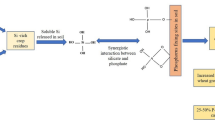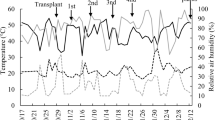Abstract
Purpose
The significance of silicon (Si) in plant nutrition has been debated for many years. Agriculture has overlooked silicon fertilization because of the common belief that soil contains sufficient Si. This has led to neglect of its potential advantages in optimal, stress-free conditions. A field experiment was conducted to evaluate the effect of foliar spray of orthosilicic acid (OSA) on the growth, yield, nutrient content, and quality of fodder maize.
Methods
The experiment consisted seven treatments with different concentrations of OSA (0.05%, 0.10%, 0.15%, 0.20%, 0.25%, and 0.30%) were applied at 30 DAS stage along with the recommended dose of fertilizer (RDF 120–26-33 kg N-P-K/ha). RDF without OSA application was used as control.
Results
The results showed that OSA application significantly improved green fodder yield (GFY) and dry fodder yield (DFY). 0.25% OSA concentration resulted in the highest GFY (53.63 t ha−1) and DFY (13.35 t ha−1), which were 10.6% and 45.3% higher over control, respectively. The application of OSA also positively influenced growth parameters such as crop growth rate (CGR), relative growth rate (RGR), dry matter accumulation (DMA), leaf:stem ratio, and physiological parameters including SPAD (chlorophyll content), relative water content (RWC%), and leaf area index (LAI). OSA foliar spray improved the nutrient content and uptake in fodder maize. Nitrogen (N%), potassium (K%), and calcium (Ca%) concentrations were significantly increased with OSA application, while phosphorus (P%) concentration remained unaffected. The uptake of N, P, K, and Ca was significantly higher in the OSA-treated plots, with 0.25% OSA treatment showing the highest nutrient uptake. OSA application improved dry matter (DM%) by 11.3%, crude protein (CP%) 1.3%, total ash (TA%) 3.3%, and lowered neutral detergent fiber (NDF%) 2.0%, and acid detergent fiber (ADF%) 2.7%. Economic analysis revealed that OSA at 0.25% concentration resulted in the highest gross return, net return, and benefit–cost ratio (B:C), indicating its economic viability.
Conclusion
Therefore, foliar spray of OSA, at 0.25% concentration, at 30 DAS improved the growth, yield, nutrient content, and quality of fodder maize. This study highlights the potential of OSA as a beneficial foliar spray for enhancing production and quality of fodder maize.
Similar content being viewed by others
Data Availability
Supplementary materials are provided.
References
Aldal’in HKH (2017) Effect of poultry litter on protein, oil and mineral contents of Maize (Zea mays L)
Ávila FW, Baliza DP, Faquin V et al (2010) Interação entre silício e nitrogênio em arroz cultivado sob solução nutritiva. Rev Ciênc Agron 41:184–190. https://doi.org/10.1590/S1806-66902010000200003
Bassi D, Menossi M, Mattiello L (2018) Nitrogen supply influences photosynthesis establishment along the sugarcane leaf. Sci Rep 8:2327. https://doi.org/10.1038/s41598-018-20653-1
Biswal B, Kashyap S, Bhattacharjee S et al (2022) Scope of Horse Gram and Bambara Groundnut as source of food and feed legume: A Review. LR. https://doi.org/10.18805/LR-4875
Bokor B, Ondoš S, Vaculík M et al (2017) Expression of genes for Si uptake, accumulation, and correlation of Si with other elements in ionome of maize kernel. Front Plant Sci 8:1063. https://doi.org/10.3389/fpls.2017.01063
Borawska-Jarmułowicz B, Mastalerczuk G, Janicka M, Wróbel B (2022) Effect of silicon-containing fertilizers on the nutritional value of grass–legume mixtures on temporary grasslands. Agriculture 12:145. https://doi.org/10.3390/agriculture12020145
Coradin T, Livage J (2001) Effect of some amino acids and peptides on silicic acid polymerization. Colloids Surf, B 21:329–336. https://doi.org/10.1016/S0927-7765(01)00143-6
Cuong TX, Ullah H, Datta A, Hanh TC (2017) Effects of silicon-based fertilizer on growth, yield and nutrient uptake of rice in tropical zone of Vietnam. Rice Sci 24:283–290. https://doi.org/10.1016/j.rsci.2017.06.002
Currie HA, Perry CC (2007) Silica in Plants: Biological, Biochemical and Chemical Studies. Ann Bot 100:1383–1389. https://doi.org/10.1093/aob/mcm247
Desoky E-SM, Mansour E, El-Sobky E-SEA et al (2021) Physio-Biochemical and agronomic responses of faba beans to exogenously applied nano-silicon under drought stress conditions. Front Plant Sci 12:637783. https://doi.org/10.3389/fpls.2021.637783
Fernández-Escobar R (2019) Olive nutritional status and tolerance to biotic and abiotic stresses. Front Plant Sci 10:1151. https://doi.org/10.3389/fpls.2019.01151
Gomez KA, Gomez AA (1984) Statistical procedures for agricultural research, 2nd edn. J. Wiley & sons, New York Chichester Brisbane [etc.]
Gou T, Yang L, Hu W et al (2020) Silicon improves the growth of cucumber under excess nitrate stress by enhancing nitrogen assimilation and chlorophyll synthesis. Plant Physiol Biochem 152:53–61. https://doi.org/10.1016/j.plaphy.2020.04.031
Greger M, Landberg T, Vaculík M (2018) Silicon influences soil availability and accumulation of mineral nutrients in various plant species. Plants 7:41. https://doi.org/10.3390/plants7020041
Harrison (formerly Perry) CC (1996) Evidence for intramineral macromolecules containing protein from plant silicas. Phytochemistry 41:37–42. https://doi.org/10.1016/0031-9422(95)00576-5
Jackson ML (1973) Soil chemical analysis, pentice hall of India Pvt. Ltd, New Delhi, India 498:151–154
Jawahar S, Ramesh S, Suseendran K et al (2019) Effect of ortho silicic acid formulations on productivity and profitability of maize. Plant Arch 19:1214–1218
Jawahar S, Vaiyapuri V, Sriramachandrasekharan MV et al (2009) Effect of silicon on growth and yield of maize. In: Proceedings of the National Seminar on Recent Advances in Soil Health and Crop Management for Sustainable Agriculture. pp 170–172
Laane H-M (2018) The effects of foliar sprays with different silicon compounds. Plants 7:45. https://doi.org/10.3390/plants7020045
Lewin J, Reimann BEF (1969) Silicon and plant growth. Annu Rev Plant Physiol 20:289–304. https://doi.org/10.1146/annurev.pp.20.060169.001445
Liang Y (1999) Effects of silicon on enzyme activity and sodium, potassium and calcium concentration in barley under salt stress. Plant Soil 209:217–224. https://doi.org/10.1023/A:1004526604913
Liang Y, Wong JWC, Wei L (2005) Silicon-mediated enhancement of cadmium tolerance in maize (Zea mays L.) grown in cadmium contaminated soil. Chemosphere 58:475–483. https://doi.org/10.1016/j.chemosphere.2004.09.034
Liang Y, Zhang W, Chen Q, Ding R (2005) Effects of silicon on H+-ATPase and H+-PPase activity, fatty acid composition and fluidity of tonoplast vesicles from roots of salt-stressed barley (Hordeum vulgare L.). Environ Exp Bot 53:29–37. https://doi.org/10.1016/j.envexpbot.2004.02.010
Liu Z, Gao F, Yang J et al (2019) Photosynthetic characteristics and uptake and translocation of nitrogen in peanut in a wheat–peanut rotation system under different fertilizer management regimes. Front Plant Sci 10:86. https://doi.org/10.3389/fpls.2019.00086
Luyckx M, Hausman J-F, Lutts S, Guerriero G (2017) Silicon and plants: current knowledge and technological perspectives. Front Plant Sci 8:411. https://doi.org/10.3389/fpls.2017.00411
Mali M, Aery NC (2008) Influence of silicon on growth, relative water contents and uptake of silicon, calcium and potassium in wheat grown in nutrient solution. J Plant Nutr 31:1867–1876. https://doi.org/10.1080/01904160802402666
Neeru J, Shaliesh C, Vaishali T et al (2019) Role of orthosilicic acid (OSA) based formulation in improving plant growth and development. Silicon 11:2407–2411. https://doi.org/10.1007/s12633-015-9380-x
Olle M, Schnug E (2016) The effect of foliar applied silicic acid on growth and chemical composition of tomato transplants. Journal of Cultivated Plants/Journal für Kulturpflanzen 68:8
Pati S, Pal B, Badole S et al (2016) Effect of silicon fertilization on growth, yield, and nutrient uptake of rice. Commun Soil Sci Plant Anal 47:284–290. https://doi.org/10.1080/00103624.2015.1122797
Pavlovic J, Kostic L, Bosnic P et al (2021) Interactions of silicon with essential and beneficial elements in plants. Front Plant Sci 12:697592. https://doi.org/10.3389/fpls.2021.697592
Pei ZF, Ming DF, Liu D et al (2010) Silicon improves the tolerance to water-deficit stress induced by polyethylene glycol in wheat (Triticum aestivum L.) Seedlings. J Plant Growth Regul 29:106–115. https://doi.org/10.1007/s00344-009-9120-9
Radford PJ (1967) Growth analysis formulae - their use and abuse. Crop Sci 7:171–175. https://doi.org/10.2135/cropsci1967.0011183X000700030001x
Sahebi M, Hanafi MM, Siti Nor Akmar A et al (2015) Importance of silicon and mechanisms of biosilica formation in plants. Biomed Res Int 2015:396010. https://doi.org/10.1155/2015/396010
Sangster AG, Hodson MJ, Tubb HJ (2001) Chapter 5 Silicon deposition in higher plants. In: Studies in Plant Science. Elsevier 8:85–113. https://doi.org/10.1016/S0928-3420(01)80009-4
Sharma JD, Patel KC, Bhavani RM (2013) Yield attributes, chlorophyll content and biometric yield of maize (Zea mays L.) as influenced by silicon application under cadmium contaminated soil. An Asian J Soil Sci 8(2):334–338
Smith GS, Nelson AB, Boggino EJA (1971) Digestibility of forages in vitro as affected by content of “Silica”2. J Anim Sci 33:466–471. https://doi.org/10.2527/jas1971.332466x
Sonobe K, Hattori T, An P et al (2010) Effect of silicon application on sorghum root responses to water stress. J Plant Nutr 34:71–82. https://doi.org/10.1080/01904167.2011.531360
Soratto RP, Crusciol CAC, Castro GSA et al (2012) Leaf application of silicic acid to white oat and wheat. Rev Bras Ciênc Solo 36:1538–1544. https://doi.org/10.1590/S0100-06832012000500018
Van Soest PJ, Robertson JB, Lewis BA (1991) Methods for dietary fiber, neutral detergent fiber, and nonstarch polysaccharides in relation to animal nutrition. J Dairy Sci 74:3583–3597. https://doi.org/10.3168/jds.S0022-0302(91)78551-2
Watson DJ (1947) Comparative physiological studies on the growth of field crops: I. Variation in net assimilation rate and leaf area between species and varieties, and within and between years. Ann Bot 11:41–76
Zhu Y-X, Gong H-J, Yin J-L (2019) Role of silicon in mediating salt tolerance in plants: a review. Plants 8:147. https://doi.org/10.3390/plants8060147
Acknowledgements
The authors wish to acknowledge Director, ICAR–National Dairy Research Institute for and ICAR–Central Soil Salinity Research Institute for providing laboratory and field staff facility for completion of this study. The authors also acknowledge ICAR–National Dairy Research Institute for granting fellowship during the study period.
Funding
None.
Author information
Authors and Affiliations
Contributions
Conceptualization, plan of research and lab facility by Bisworanjita Biswal, Rakesh Kumar, Ashwani Kumar, Rajesh Kumar Meena, Hardev Ram and Arvind Kumar Rai. Field and lab experimentation, observation recording, manuscript writing was done by Bisworanjita Biswal. Assistance in lab analysis by Suryankanta Kashyap. Statistical data analysis by Subhradip Bhatacharjee and Kirttiranjan Baral. Manuscript correction by Rajeswari Das and Smrutirekha Pradhan. Formatting and final drafting by Biswajit Rana and Birbal.
Corresponding author
Ethics declarations
Ethics Approval
Not applicable.
Consent to Participate
All authors agreed with the concentration and all of them gave explicit consent to submit.
Consent for Publication
We have the consent of the authors for the publication.
Competing Interests
The authors declare no competing interests.
Additional information
Publisher's Note
Springer Nature remains neutral with regard to jurisdictional claims in published maps and institutional affiliations.
Supplementary Information
Below is the link to the electronic supplementary material.
Rights and permissions
Springer Nature or its licensor (e.g. a society or other partner) holds exclusive rights to this article under a publishing agreement with the author(s) or other rightsholder(s); author self-archiving of the accepted manuscript version of this article is solely governed by the terms of such publishing agreement and applicable law.
About this article
Cite this article
Biswal, B., Kumar, R., Kumar, A. et al. Enhancing Growth, Yield, and Nutrient Quality of Fodder Maize Through Foliar Application of Ortho Silicic Acid. Silicon 16, 559–571 (2024). https://doi.org/10.1007/s12633-023-02691-1
Received:
Accepted:
Published:
Issue Date:
DOI: https://doi.org/10.1007/s12633-023-02691-1




